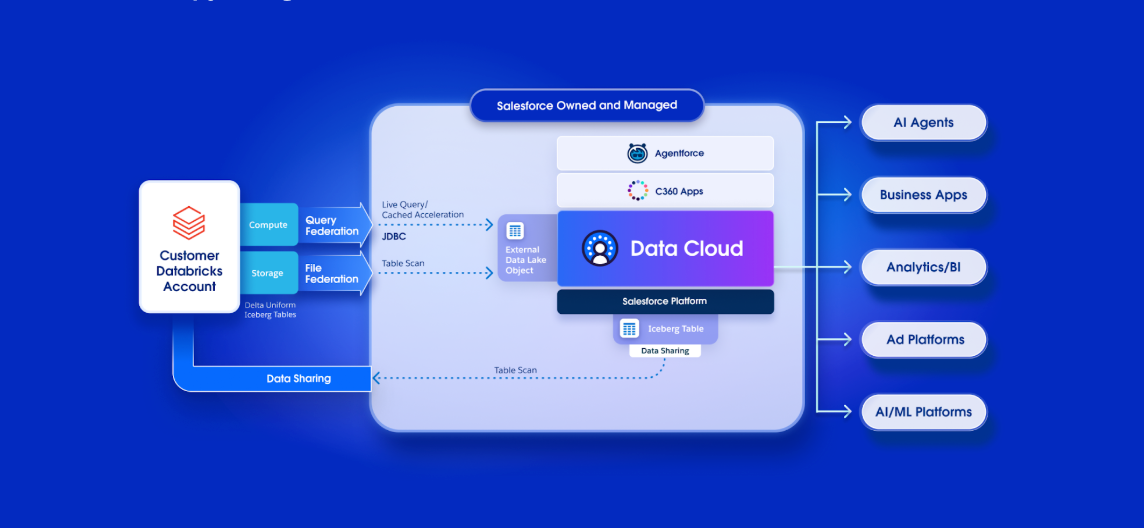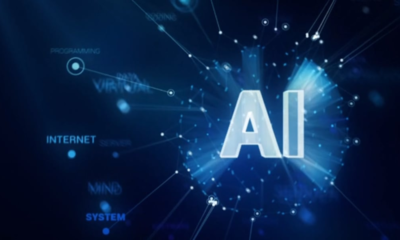AI Research
Unleashing the Power of Zero Copy

This integration kills the need for slow ETL pipelines by allowing Salesforce and Databricks to access each other’s data in real-time, right where it lives.
Salesforce and Databricks are tearing down the walls between their data platforms. The two enterprise giants have announced the General Availability of a bi-directional, Zero Copy integration, signaling a major shift away from the slow, costly data pipelines that have plagued businesses for decades. The new integration allows Salesforce Data Cloud and the Databricks Data Intelligence Platform to access each other’s data in near real-time, without making copies.
For years, the holy grail of a 360-degree customer view has been a mirage, shimmering behind a desert of brittle ETL processes and stale data. Companies keep their transactional and log data in powerful lakehouses like Databricks, while their customer relationship data lives in CRMs like Salesforce. Getting them to talk to each other meant building complex, expensive pipelines to constantly copy data back and forth. By the time the data arrived, it was already out of date.
This announcement aims to end that. According to the announcement, the integration works in two directions. First, using a new feature called Zero Copy File Federation, Salesforce can now directly access and use massive datasets stored in Databricks. It doesn’t query the data in a traditional sense; it pulls directly from the underlying Apache Iceberg tables at the storage layer. This means a service agent in Salesforce can see a customer’s complete, up-to-the-minute transaction history—billions of rows of it—without putting any computational strain on the Databricks source system.
The second direction, Zero Copy File Sharing, allows the curated and unified customer profiles built in Salesforce Data Cloud to be shared directly into the Databricks Unity Catalog. This gives data scientists and AI developers in the Databricks environment live access to the “golden record” of a customer. They can run analytics or train machine learning models on the freshest possible data without waiting for a nightly data dump.
This move is about more than just convenience; it’s about enabling a new class of applications, particularly in the realm of AI. The source highlights a key use case: “agentic AI.” These are AI agents that can do more than just chat; they can take action. With this live, bi-directional data flow, an AI agent within Salesforce can instantly access a customer’s entire history from the data lake to resolve a complex warranty issue or trigger a personalized marketing campaign based on a purchase that happened seconds ago.
The End of the Data Pipeline as We Know It?
This integration is a direct assault on the old way of doing things. The era of ETL—Extract, Transform, Load—is being challenged by a new philosophy: access data where it lives. By eliminating the need for data duplication, Salesforce and Databricks are not just saving customers money on storage and compute; they are fundamentally changing the speed at which businesses can operate.
The implications ripple across the organization. Data engineers can pivot from being digital plumbers, constantly fixing broken pipelines, to becoming data architects who govern secure, real-time access. Business analysts no longer have to preface their insights with “as of last night’s data refresh.” And marketers can finally execute campaigns based on real-time customer behavior, not historical snapshots.
Consider the retail example provided in the announcement. A fictional company, Northern Trail Outfitters, stores petabytes of customer transaction data in Databricks Delta tables. Their customer service and marketing data resides in Salesforce. With the new integration, they can securely connect the two systems. A data specialist maps the external transaction data to the Salesforce Data Model, creating a unified customer profile.
Suddenly, a service agent looking at a contact record in Salesforce can see the customer’s last ten transactions, pulled live from Databricks. An AI-powered service bot can handle inquiries about those transactions with perfect accuracy because it’s accessing the source of truth. A marketing automation flow can trigger a high-value offer the instant a customer’s monthly spending, calculated from the lakehouse data, crosses a specific threshold.
Crucially, the value flows both ways. After Salesforce’s Identity Resolution engine unifies disparate profiles into a single, cohesive customer view, that enriched data can be shared back to Databracks. Now, data scientists can use Databricks’ powerful MosaicAI platform to build more accurate churn prediction or lifetime value models using the most complete customer dataset imaginable.
This strategic partnership is also a significant move in the broader data platform wars. While Snowflake pioneered the concept of data sharing, this deep, bi-directional integration between the dominant CRM platform and a leading data lakehouse powerhouse creates a formidable ecosystem. It’s a clear signal that the future of enterprise data isn’t about choosing one cloud or one platform to rule them all. Instead, it’s about creating a fluid, interoperable data fabric that allows businesses to use the best tool for the job without creating new data silos.
By making data fluid and accessible, Salesforce and Databricks are providing the fuel for the next generation of AI-driven customer experiences. The promise of unleashing the power of enterprise data has been around for a long time, but by finally bridging the gap between the system of engagement and the system of record, this integration makes that promise feel closer to reality than ever before. It’s a technical feat that translates into a simple business outcome: moving from data to decisions, instantly.
AI Research
Databricks at a crossroads: Can its AI strategy prevail without Naveen Rao?

“Databricks is in a tricky spot with Naveen Rao stepping back. He was not just a figurehead, but deeply involved in shaping their AI vision, particularly after MosaicML,” said Robert Kramer, principal analyst at Moor Insights & Strategy.
“Rao’s absence may slow the pace of new innovation slightly, at least until leadership stabilizes. Internal teams can keep projects on track, but vision-driven leaps, like identifying the ‘next MosaicML’, may be harder without someone like Rao at the helm,” Kramer added.
Rao became a part of Databricks in 2023 after the data lakehouse provider acquired MosaicML, a company Rao co-founded, for $1.3 billion. During his tenure, Rao was instrumental in leading research for many Databricks products, including Dolly, DBRX, and Agent Bricks.
AI Research
NFL player props, odds: Week 2, 2025 NFL picks, SportsLine Machine Learning Model AI predictions, SGP

The Under went 12-4 in Week 1, indicating that not only were there fewer points scored than expected, but there were also fewer yards gained. Backing the Under with NFL prop bets was likely profitable for the opening slate of games, but will that maintain with Week 2 NFL props? Interestingly though, four of the five highest-scoring games last week were the primetime games, so if that holds, then the Overs for this week’s night games could be attractive with Week 2 NFL player props.
There’s a Monday Night Football doubleheader featuring star pass catchers like Nico Collins, Mike Evans and Brock Bowers. The games also feature promising rookies such as Ashton Jeanty, Omarion Hampton and Emeka Egbuka. Prop lines are usually all over the place early in the season as sportsbooks attempt to establish a player’s potential, and you could take advantage of this with the right NFL picks. If you are looking for NFL prop bets or NFL parlays for Week 2, SportsLine has you covered with the top Week 2 player props from its Machine Learning Model AI.
Built using cutting-edge artificial intelligence and machine learning techniques by SportsLine’s Data Science team, AI Predictions and AI Ratings are generated for each player prop.
Now, with the Week 2 NFL schedule quickly approaching, SportsLine’s Machine Learning Model AI has identified the top NFL props from the biggest Week 2 games.
Week 2 NFL props for Sunday’s main slate
After analyzing the NFL props from Sunday’s main slate and examining the dozens of NFL player prop markets, the SportsLine’s Machine Learning Model AI says Lions receiver Amon-Ra St. Brown goes Over 63.5 receiving yards (-114) versus the Bears at 1 p.m. ET. Detroit will host this contest, which is notable as St. Brown has averaged 114 receiving yards over his last six home games. He had at least 70 receiving yards in both matchups versus the Bears a year ago.
Chicago allowed 12 receivers to go Over 63.5 receiving yards last season as the Bears’ pass defense is adept at keeping opponents out of the endzone but not as good at preventing yardage. Chicago allowed the highest yards per attempt and second-highest yards per completion in 2024. While St. Brown had just 45 yards in the opener, the last time he was held under 50 receiving yards, he then had 193 yards the following week. The SportsLine Machine Learning Model projects 82.5 yards for St. Brown in a 4.5-star pick. See more Week 2 NFL props here.
Week 2 NFL props for Vikings vs. Falcons on Sunday Night Football
After analyzing Falcons vs. Vikings props and examining the dozens of NFL player prop markets, the SportsLine’s Machine Learning Model AI says Falcons running back Bijan Robinson goes Over 65.5 rushing yards (-114). Robinson ran for 92 yards and a touchdown in Week 14 of last season versus Minnesota, despite the Vikings having the league’s No. 2 run defense a year ago. The SportsLine Machine Learning Model projects Robinson to have 81.8 yards on average in a 4.5-star prop pick. See more NFL props for Vikings vs. Falcons here.
You can make NFL prop bets on Robinson, Justin Jefferson and others with the Underdog Fantasy promo code CBSSPORTS2. Pick at Underdog Fantasy and get $50 in bonus funds after making a $5 wager:
Week 2 NFL props for Buccaneers vs. Texans on Monday Night Football
After analyzing Texans vs. Buccaneers props and examining the dozens of NFL player prop markets, the SportsLine’s Machine Learning Model AI says Bucs quarterback Baker Mayfield goes Under 235.5 passing yards (-114). While Houston has questions regarding its offense, there’s little worry about the team’s pass defense. In 2024, Houston had the second-most interceptions, the fourth-most sacks and allowed the fourth-worst passer rating. Since the start of last year, and including the playoffs, the Texans have held opposing QBs under 235.5 yards in 13 of 20 games. The SportsLine Machine Learning Model forecasts Mayfield to finish with just 200.1 passing yards, making the Under a 4-star NFL prop. See more NFL props for Buccaneers vs. Texans here.
You can also use the latest FanDuel promo code to get $300 in bonus bets instantly:
Week 2 NFL props for Chargers vs. Raiders on Monday Night Football
After analyzing Raiders vs. Chargers props and examining the dozens of NFL player prop markets, the SportsLine’s Machine Learning Model AI says Chargers quarterback Justin Herbert goes Under 254.5 passing yards (-114). The Raiders’ defense was underrated in preventing big passing plays a year ago as it ranked third in the NFL in average depth of target allowed. It forced QBs to dink and dunk their way down the field, which doesn’t lead to big passing yardages, and L.A. generally prefers to not throw the ball anyway. Just four teams attempted fewer passes last season than the Chargers, and with L.A. running for 156.5 yards versus Vegas last season, Herbert shouldn’t be overly active on Monday night. He’s forecasted to have 221.1 passing yards in a 4.5-star NFL prop bet. See more NFL props for Chargers vs. Raiders here.
How to make Week 2 NFL prop picks
SportsLine’s Machine Learning Model has identified another star who sails past his total and has dozens of NFL props rated 4 stars or better. You need to see the Machine Learning Model analysis before making any Week 2 NFL prop bets.
Which NFL prop picks should you target for Week 2, and which quarterback has multiple 5-star rated picks? Visit SportsLine to see the latest NFL player props from SportsLine’s Machine Learning Model that uses cutting-edge artificial intelligence to make its projections.
AI Research
In the News: Thomas Feeney on AI in Higher Education – Newsroom

“I had an interesting experience over the summer teaching an AI ethics class. You know plagiarism would be an interesting question in an AI ethics class … They had permission to use AI for the first written assignment. And it was clear that many of them had just fed in the prompt, gotten back the paper and uploaded that. But rather than initiate a sort of disciplinary oppositional setting, I tried to show them, look, what you what you’ve produced is kind of generic … and this gave the students a chance to recognize that they weren’t there in their own work. This opened the floodgates,” Feeney said.
“I think the focus should be less on learning how to work with the interfaces we have right now and more on just graduate with a story about how you did something with AI that you couldn’t have done without it. And then, crucially, how you shared it with someone else,” he continued.
-

 Business2 weeks ago
Business2 weeks agoThe Guardian view on Trump and the Fed: independence is no substitute for accountability | Editorial
-
Tools & Platforms1 month ago
Building Trust in Military AI Starts with Opening the Black Box – War on the Rocks
-

 Ethics & Policy2 months ago
Ethics & Policy2 months agoSDAIA Supports Saudi Arabia’s Leadership in Shaping Global AI Ethics, Policy, and Research – وكالة الأنباء السعودية
-

 Events & Conferences4 months ago
Events & Conferences4 months agoJourney to 1000 models: Scaling Instagram’s recommendation system
-

 Jobs & Careers2 months ago
Jobs & Careers2 months agoMumbai-based Perplexity Alternative Has 60k+ Users Without Funding
-

 Podcasts & Talks2 months ago
Podcasts & Talks2 months agoHappy 4th of July! 🎆 Made with Veo 3 in Gemini
-

 Education2 months ago
Education2 months agoVEX Robotics launches AI-powered classroom robotics system
-

 Education2 months ago
Education2 months agoMacron says UK and France have duty to tackle illegal migration ‘with humanity, solidarity and firmness’ – UK politics live | Politics
-

 Podcasts & Talks2 months ago
Podcasts & Talks2 months agoOpenAI 🤝 @teamganassi
-

 Funding & Business2 months ago
Funding & Business2 months agoKayak and Expedia race to build AI travel agents that turn social posts into itineraries





















